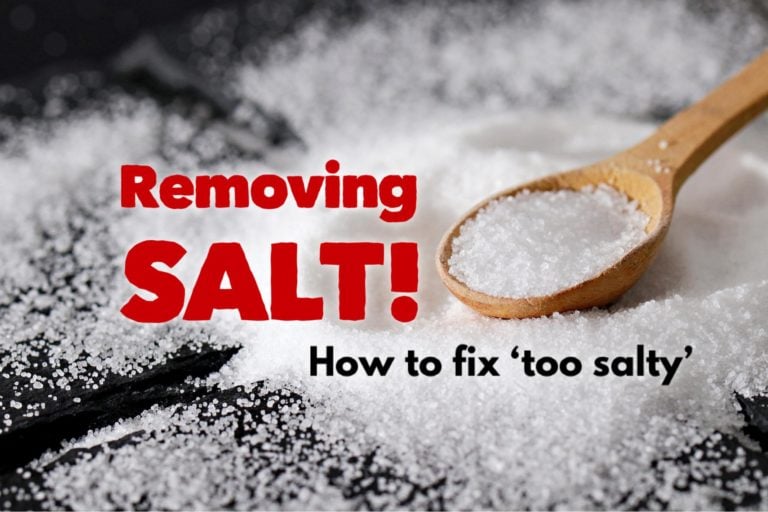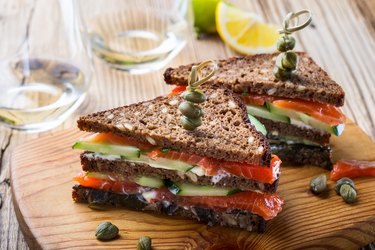Overly-salty foods can ruin a good meal. Once bacon and pancetta are seasoned, they can lose some of their saltiness, but once meat is seasoned, it’s impossible to take the saltiness away. However, you can salvage a salty meat dish by making an acidic sauce to go with it.
Sausage is a beloved breakfast food for many, but the high sodium content can be off-putting, especially if you’re watching your salt intake. Thankfully, there are easy methods to remove some of the salt from sausage so you can enjoy it guilt-free! In this comprehensive guide, we’ll explore different techniques to reduce sodium and make sausage less salty.
Why Is There So Much Salt in Sausage?
Before jumping into salt removal methods, it helps to understand why sausage contains so much sodium in the first place. There are a few reasons:
-
Salt acts as a preservative, extending the shelf life of sausage. It inhibits bacterial growth.
-
Salt enhances flavor, The salty taste makes the spices and seasonings pop
-
Salt firms up the texture of sausage. It extracts moisture to give the meat a springy bite.
-
Salt is used in the curing process for some sausages like pepperoni.
With these important functions, it’s no wonder sausage can have over 400mg sodium per serving! Even “low-sodium” options hover around 200mg. For those on a restricted diet that’s a lot of salt to take in at breakfast.
Simple Ways to Remove Salt from Sausage
If you don’t want to give up sausage entirely but need to reduce the saltiness, these methods can help:
Method 1: Soak it Out
Soaking sausage in water is an easy salt-removal trick. The water draws out the salt via osmosis, diffusing it from the high concentration in the meat to the lower concentration in the water.
To soak sausage:
-
Place sausage in a bowl and cover with cool water. Use enough water to submerge the meat.
-
Let soak for 2-3 hours, up to overnight for maximum salt removal.
-
Drain and pat dry before cooking as usual.
Soaking can remove up to 10% of the sodium from processed sausages. The longer the soak, the more salt is diluted.
Method 2: Parboil and Rinse
Parboiling sausage before cooking drives salt out through heat. Follow up with a good rinse to wash away the drawn-out sodium.
Here’s how to parboil and rinse:
-
In a pot, cover sausage with water and bring to a boil.
-
Boil for about 5 minutes only. We’re parboiling, not fully cooking through.
-
Drain and rinse the sausage under cool water, rubbing gently.
-
Pat dry and finish cooking as usual.
The hot water pulls salt to the surface of the meat, allowing more sodium to be rinsed away. A quick boil is sufficient.
Method 3: Cook in Broth or Milk
Cooking sausage in broth or milk instead of frying or grilling can also cut down on saltiness. The liquids work to extract salt and dilute the sausage as it cooks.
-
For broth, use low-sodium chicken or vegetable broth to avoid adding more salt.
-
Milk has a subtle sweetness that counters saltiness. Whole milk works best.
-
Cook sausage in the broth or milk over medium heat until fully cooked through.
The broth or milk will become salty, but the sausage itself will be less so. Be sure to salt any dishes containing the sausage accordingly.
Tips for Further Reducing Sodium in Sausage
In addition to these salt-removal methods, there are other ways to cut down the sodium when cooking with sausage:
-
Opt for turkey or chicken sausage over pork varieties. They have less inherent sodium since poultry is less salty.
-
Look for sausages cured with spices instead of salt, like allspice, cloves, and nutmeg.
-
Mix regular sausage with lean ground meat like turkey or bison for a less salty blend.
-
Season cooked sausage with onion, garlic, herbs, lemon, and other flavors to mask saltiness.
-
Avoid cooking methods that use salt, like frying or salting while grilling. Stick to baking, broiling, or poaching.
-
Be mindful of salty accompaniments like cheese, condiments, and salty breakfast sides.
Make Your Own Low-Sodium Sausage
For the ultimate control over sodium levels, make sausage from scratch. With a basic sausage seasoning recipe, it’s easy to customize the ingredients.
Here’s an example recipe for homemade breakfast sausage:
Ingredients:
-
1 lb ground pork
-
1 tsp dried sage
-
1 tsp dried thyme
-
1/2 tsp crushed red pepper flakes
-
1/2 tsp black pepper
-
1/4 tsp ground nutmeg
-
1 garlic clove, minced
-
1/2 tsp salt (optional)
Instructions:
-
In a bowl, mix pork with all spices, herbs, garlic, and optional salt. Use clean hands to thoroughly combine.
-
Form into patties or cook in crumbles as desired.
-
Cook on the stovetop or bake at 400°F until sausage reaches an internal temperature of 160°F.
Make a big batch and freeze extras so you always have homemade sausage ready! Adjust seasonings to your taste and leave out salt entirely or use a small amount.
Savor the Savory, Not the Salty
With these handy techniques for removing salt from sausage, you can continue to enjoy this popular breakfast meat while controlling your sodium intake. A short soak, quick parboil, or cooking in broth/milk can significantly reduce the saltiness with minimal effort. Plus, whipping up your own sausage gives you total command over the salt content.
Sausage doesn’t have to be off the table if you’re watching your salt. A few simple salt-removal tricks can bring the sodium down to an acceptable level so you can savor all that savory sausage flavor, without going overboard on the salt. Give these methods a try for a less salty start to your day!

Shopping Tips for Reducing Salt
The National Kidney Foundation reports that consuming too much salt may cause high blood pressure, which can damage the kidneys over time. Most Americans ingest more than the recommended single teaspoon of salt per day, so learning how to shop for less-salty food can help.



Buy fresh meat instead of processed meat. Cured meats, such as bacon, ham and lunch meat, are notoriously high in salt. Ready-to-cook meats, like breaded chicken tenders and country-fried steak, also tend to be very salty.
When shopping for fresh or frozen chicken or turkey, choose varieties that havent been injected with a salt solution, advises the American Heart Association (AHA). To avoid them, check the label for terms such as “saline,” “broth” and “sodium solution.”
When possible, select fresh or frozen vegetables, instead of canned varieties. If you need the convenience of canned food, look for those labeled “no salt added. ” Also, choose reduced-sodium condiments such as soy sauce, ketchup and salad dressing.
Remove Salt From Meat
Video of the Day
Is your homemade bacon too salty after smoking, or is your pancetta too salty? All is not lost. In an interview with LIVESTRONG. Jason Fullilove, chef in residence at Abernethys in Los Angeles, tells com that the issue can be solved in a simple way. “Put meats cured with salt in a pan with some water, and simmer them for a few minutes. Then, discard the water and continue cooking in a little olive oil. This will make crispy bacon or pancetta with less salt. “.



Video of the Day
Unfortunately, this method isnt feasible for other meat dishes, such as steak, hamburger, meatloaf and meatballs. Frank Proto, director of culinary operations at the Institute of Culinary Education tells LIVESTRONG.com how to make them palatable. “Once salt is added, you cant remove it, but there is a way to reduce the salty taste. For example, you can pair an overly salted grilled steak with a chimichurri sauce that is acidic. The acid balances the salt.”
“Meatballs are harder to make because the salt is inside the meat.” That could be fixed by serving it with a sauce that is either acidic or a little less salty. A simple tomato sauce with little or no salt would work. “.
Read more: How to Neutralize Salt in Food
How To REDUCE SODIUM In Pre-Made Sausage Patties
FAQ
How to neutralize salt in meat?
How to take salt out of processed meat?
Does boiling remove salt from meat?
How to remove salt from pork?
How do you remove salt from sausage?
One of the easiest ways to remove salt from sausage is to soak it in water for a few hours. This will help draw out some of the salt and make the sausage less salty. To do this, simply place the sausage in a bowl or container and cover it with water. Let it soak for at least 2-3 hours, or overnight if possible.
How does one eliminate salt from their body?
Sodium is an essential nutrient for human health. It assists in conducting nerve impulses, contracting and relaxing muscles, and significantly contributes to the balance of water and nutrients in the blood. Rather than attempting to “eliminate” sodium from the body, it is recommended to consume at least 500 mg of sodium per day, and limit your intake to 2300 mg per day.
How do you make sausage less salty?
To do this, simply place the sausage in a pot or skillet and add enough unsalted broth or water to cover it halfway. Bring the liquid to a boil, then reduce the heat and let the sausage simmer until cooked through. The broth or water will help to draw out some of the salt and make the sausage less salty.
How do you lower sodium if you eat sausage?
A great solution to lower your sodium and still enjoy sausage is to you make your own. Don’t worry, you don’t have to buy sausage casings to make this great treat, which you can use at the holidays in your family’s favorite sausage stuffing, or serve as patties on Christmas or New Years. Mix all ingredients together in a large bowl.
